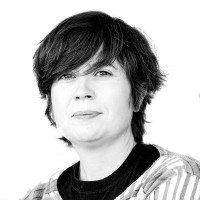Cows in stables, not in milk and manure factories
- The farmers of the French State intend to paralyse the gigantic farm that will house over 1,000 cows plus 800 heifers. If it is that size, in Caparroso de Navarra. And in India, multinationals want to build a total of 40,000 cows. Farmers teach us what cheap milk hides.

They are called 1,000 vaches, although they can house over 1,000 cows in buildings gigantescos.Uno is in Caparroso de Navarra, with 1,800 cows and can spread up to 4,000... Were you? The factory, better said. In the northern part of the French state, in the village of Drucat, in the area of Amiens, the industrial Michel Ramery has been built and evicted from various tools by the militant farmers of the Confederation Paysanne last May. Police, debate with the minister, arrest of those responsible, trial session last week... The Confesbask trade unionists have brought to the tables the ugly secret of milk they buy so cheap in hypermarkets.
The Secretary General of the union, which includes the Unión Campesina del País Vasco (ELB), Mikel Hiribarrena, in his article “The Silence of the Industry in Cultivation” the details of the mega-cattle attacked. Confesbask has graphically explained the subject on his website: “Aujour d’hui parlons de la ferme de 1.000 vaches et analysons cette usine à gaz”. These gases are astonishing, no doubt.
The 1,000 cows that will live in buildings totalling 8,500 square meters will distribute 27,000 litres of milk a day on four descents that will be made by the workers (all women). The farm will be supplied with 160,000 liters of water per day throughout the day. They'll be brought in 100 tons of food to the cows to make 73,000 kilos of manure in addition to milk.
Manure is one of the economic keys to smell. Mixed cow dung with other incontrovertible plants, they will produce methane in a plant that has a capacity of 1.5 MegaWatts to easily convert it into electricity. What is called green energy, it seems that in France there are still good premiums; in the Spanish State they are better lucky than those who want to do business by creating energy with excrements and have been stunned by cuts.
The organic waste remaining after manure metallization is intended to be distributed in some 3,000 hectares of the area. This has led to complaints from those concerned about the environment in the Somme Valley, as groundwater reserves will be further contaminated with nitrate.
To the environment must be added the resentment to health. In these types of pavilions each cow does not have for itself half the space a car offers in the car park, so the animals that will survive without knowing the day and the outdoors should be content with antibiotics and other medications to keep them alive. Next, neighbors and neighbors will devour their own beds and meats.
Cows, in addition to milk, will spread their shit around. On the contrary, their food will be brought from afar. More than half of them from South America, GMO grains and feed well rubbed with pesticides. As a counterpart, milk will also spread to the four winds of the world, under the low prices obtained. A system of the sinking of distant peasants as close as possible.
“This is the cheapest milk on the market”
Lots of cows, lots of milk, lots of manure... and few workers: Ramery, her employer, will move the factory with 18 workers throughout her life. In France, which has already lost most of the small farmhouses, milk is now produced in farms of some 50 cows, employing an average of 2.1 workers for each. Instead of the 42 farmers who would need to care for 1,000 cows, Ramery employs 18 unskilled and very low-paid workers.
However, Ramery wants to compete in price, knowing that passersby quickly forget the contaminations, quality, injustice and history that are mentioned from time to time in the media. If the production of one tonne of milk now costs the owner of a cowboy in the French State, Ramery will produce it in EUR 270. How? Taking advantage of economies of scale that generate gigantic quantities and sizes, charging large subsidies, paying low wages to the few workers and, finally, bringing performance to “green energy”.
“This dove of 1,000 cows is a test – Cofederation Paysanne has reported. If this does not stop, we will soon find similar jobs across France, threatening the 100,000 jobs that dairy production currently has.” And he's right. Similar and gigantic farms have already been laid down in many parts of Europe, sinking small farms. That is not to say in North America. And in Asia ...
From India comes the news that he wants to beat records: In the state of Andra Pradesh, multinationals are being built with a giant stable... 40,000 cows! The fertilizer corporation Iffco of India and the dairy multinational Fonterra of New Zealand, which produced melamine-contaminated lethal milk in China, are the drivers of this idea, the force of groups that have not yet been able to overcome it.
As the Indian issue is resolved, the Israeli Afimilk Corporation has in Vietnam the largest cow and milk production complex in the world. It produced 200 tonnes of milk a day in 2012 and its target for 2015 is to market 300,000 tonnes a year. For that, in its sheds, it has 11,000 cows and 12,000 heifers, in total 23,000 animals! Afimilk is built on two trenches, both Israelis: Kibbutza Afikim and the investment fund Fortissimi Capital.
Industry and finance have long wanted to control the entire human food chain. As Mikel Hiribarrena wrote: “It is not the silence of the industry in yesterday’s or the day before yesterday’s cultivation. We have quite a few examples right here in Euskal Herria. How many shadows do not bring so many barns, or the whole series of productions!”
Ramery, who builds the Drucat cows factory in France, is the richest man in the country, with 120 million euros, who made a fortune in public works. It has the majority of public authorities, including the leader of the majority agricultural trade union FDSEA. Everyone talks about competitive agriculture... then when it comes to large landowners and industrialists who concentrate most of the European subsidies.
On 1 July, the trade unionists of Confesbask occupied the macro-cattle plant to be tried. The case has been postponed in early October.
Automatizazioaren eta abereen inguruan kuxkuxeatzen ari nintzela, ukuilu automatizatuen informazioa hasi naiz eskuratzen. Nire idazmahaiaren erosotasunetik idazten, gizakion kontsumorako modu masiboan esplotatzen ditugun abereen bizitzak nahiko penagarriak direla iruditzen zait,... [+]
Itsasoan badira landareen itxura izan arren animalia harrapari diren izaki eder batzuk: anemonak. Kantauri itsasoan hainbat anemona espezie ditugun arren, bada bat, guztien artean bereziki erraz atzemateko aukera eskaintzen diguna: itsas-tomatea.
Kirola eta oroimena uztartuko dituzte, bigarrenez, mendi-martxa baten bitartez. Ez da lehiakorra izanen, helburua beste bat delako. La Fuga izeneko mendi martxak 1938ko sarraskia gogorarazi nahi du. Ezkabako gotorlekuan hasi eta Urepelen amaituko da. Maiatzaren 17an eginen dute.
Zer esango zenioke Palestinako aktibista bati aurrez aurre izango bazenu? Ni mutu geratu nintzen Iman Hammouri nire herrian bertan aurkeztu zidatenean. Eskerrak andre nagusi bat gerturatu zitzaigula eta solaskide roletik itzultzailearenera pasa nintzela.
Palestinako Popular... [+]
Ugaztunei eskainitako azken artikuluaren amaierako hitzak hurrengo animalia aurkezteko aitzakia paregabea dira. Bertan esaten genuen muturluzeak erreka “garbi eta txukunak” behar dituela, kutsadurarik gabeak baina elementu natural anitzekin. Animalia txiki horren... [+]





















